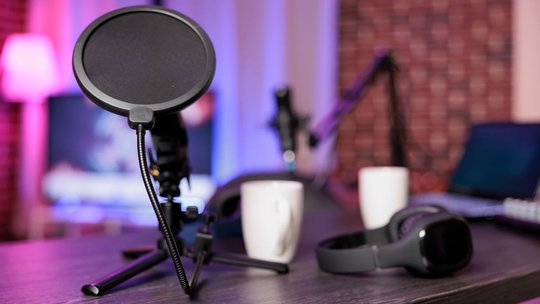Blog
How to Repurpose Your Podcast - 8 Effective Ways

Veröffentlicht am 24.7.2024 von Babalola Alabi
PodcastingThe main reason you create podcast content is for people to view and listen to it. For this reason, you should set up an effective marketing strategy to help you advertise your podcast easily and efficiently. One of the most effective strategies is re-purposing your podcast in different formats for more reach.
But how do you do that? What are the best practices to achieve desirable results from your repurposed content? In this article, we will discuss everything you need to know about re-purposing and give you the most effective ways and formats to convert your podcast. So, if you’re ready, stay chilled and read on.
What Does Repurposing your Podcast Mean?
Most times, your podcast is only limited to your podcast listeners alone. For example, if your podcast episodes are available on Spotify alone, only those with a Spotify account can access your podcast anytime. Repurposing your podcast is an effective way to reach more people outside podcast platforms like Spotify and Apple Podcast with more emphasis on creating your content in different formats that suits your audience. It breathes a new breath and life into your content.
Here is what podcast repurposing is:
- Taking an existing podcast episode and converting it into different formats like blogs, videos, infographics, and even email newsletters.
- Extracting highlights, key quotes, tips, and segments from your long podcasts to create short clips like YouTube Shorts and Instagram reels.
- Creating derivative content that builds on the original content.
Why Should You Repurpose Your Podcast Content?
From what you’ve read so far, there are some obvious reasons why repurposing your podcast is great. But here are a few more reasons:
1. Expanded Reach
Different people consume content in different ways. Your audience is not only on Spotify, they are spread all over social media and other platforms. For example, your audience may be startup CEOs and aspiring entrepreneurs, and obviously, they are not on Spotify or Apple Podcasts alone. That’s where the diversification of repurposing your podcast comes in.
2. SEO Benefits
Transcribing your podcasts and turning them into blog posts or articles can serve your audience segment that love reading blogs. In addition, since search engines crawl and index text, the written content increases your chances of appearing in search results.
3. Multiple Touchpoints
Repurposed content creates multiple touchpoints for your audience. This helps reinforce your message and increase the likelihood that your audience will remember and engage with your brand more.
4. Accessibility
Sometimes, your audience may not be in a conducive area to plug in earbuds or use a headphone to listen to your content. But with blog content or videos with transcription and subtitles, they can easily get the message. Also for hearing-impaired or visually-impaired individuals who still fall in the category of being your audience, repurposed podcasts will be of great advantage to them.
5. Authority Building
Consistently sharing high-quality content across different platforms and formats can establish you as an authority in your niche. This helps enhance your reputation and credibility and also proves that you’re an expert at what you say or do.
8 Ways to Repurpose your Podcast Content
1. Video Content (Long and Short Form)
Without any doubt, video contents are the most consumed content in the 21st century. And with the introduction of short video clips, the number has increased massively. When your audience watches you speak, they have the feeling that they are a part of the conversation and are easily entertained by that format.
There are several ways you can create videos from your podcast. You can simply pick up a camera and record a long-form video of yourself talking, it’s as simple as that. Also, AI tools like SoundMadeSeen can be used to create both short and long-form videos automatically within a few minutes. All you have to do is pick a podcast episode and create several video clips from the video. These clips can be posted on social media platforms like Instagram Reels, TikTok, and YouTube Shorts depending on your preference and audience data.
Social media logos

The Joe Rogan Experience is a perfect example of a podcast that creates long and short-form videos for its audience. Aside from recording his 2-3 hours weekly podcasts, Joe also divides the video into several clips for YouTube Shorts which has in turn driven more traffic to his podcast.
2. Audiograms
If you’re into audio podcasting, then this is a perfect fit for you. An audiogram is a visual representation of an audio clip designed to make audio content more engaging and shareable, particularly on social media. It typically combines a short audio snippet with visual elements such as a waveform animation, subtitles, and an image.
Audiograms are still relevant ways you can repurpose your audio podcasts and what makes it even better is its speed of creation these days. Descript, Wavve, and SoundMadeSeen are well-known audiogram makers that help you create audiograms quickly.
So if you don’t have a camera yet, you can create your audio podcast and convert them to audiograms easily to share on social media platforms.
3. Transcriptions
The word-for-word texts of everything spoken in your podcast is great podcast repurposing material. It helps your overall SEO through detailed transcriptions which can attract backlinks from other websites and blogs. Transcriptions also improve language and comprehension while listening because it’s usually easy to understand while hearing and reading simultaneously.
A perfect example is Leonard English’s podcast transcripts. His transcripts contain everything a transcription document needs including timestamps and highlighted words and their meanings.
Pro tip: SoundMadeSeen analyzes podcasts accurately and creates the exact transcriptions without hassle and timestamps are also added to each sentence to make the work easier for you. All you have to do is upload your podcast and transcribe!
4. Blog Posts
Another effective way to improve your SEO performance, search, and visibility is by creating SEO-optimized blogs. Raw transcripts might not rank as expected on search engines like Google but can perform better when re-edited to match SEO standards. To get started, pick out the main points from your podcast episode and discuss these points in depth adding the right keywords (in the right proportion) and optimizing your content. Make sure what you’re discussing is a relevant topic in vogue or a popular topic in your niche. This will help increase your website traffic and engagement.
Adding keywords, and making your website SEO and mobile-friendly amongst other important processes are important for your website and podcast SEO.
5. Ebooks and Guides
Your podcast contains a lot of value which could be useful in several ways rather than dispensing it. If you have a brand, you can repurpose your podcast to free ebooks to attract more customers to your brand. All you have to do is repackage your content into a lead magnet. This lead magnet could be in form of an ebook, guide, checklist, or infographic. Make an offer to your audience or potential lead to give out the repurposed content for their email or data as the case may be. With that, you can follow up and continue to send them messages and emails till they sign up for your product or service.
6. Show Notes
Creating show notes is easy and you’ll be missing out if you don’t create them for your audience. This includes timestamps, guest information, and others.
Text from show notes can be indexed by search engines which in turn improves your website’s visibility and attracts new listeners through organic search traffic.
ProTip: Creating show notes is very easy as it will take you a few minutes to create one with SoundMadeSeen. All you have to do is sign up here and begin to generate your show notes.
7. Email Marketing
Don’t be deceived, email marketing and newsletters are still in vogue and millions of people still use them even in this social media-dominated world. Upon releasing a new podcast episode, you can create email content from your email list in form of guides, freebies, bonus materials, and behind-the-scene activities to engage them better. However, before choosing the email content, listen to the podcast well to decide what type of content is best suitable for the podcast.
8. Images and Infographics
Eye-catching infographics are shareable and can also be saved to your audience's devices. Also, they add some SEO benefits to your content when you add alt text and captions with your keyword in it. The goal here is to create an unforgettable infographic from your podcast and add it to your blog content. Tools like Canva can be used to easily create them. Make sure it has a strong heading, a well-outlined layout, great design, and accurate information for your audience.
Final Thought on Repurposing your Podcast

Your podcast marketing and promotion plan is not complete without repurposing your content. Social media, emails, blogs and other platforms are available for people to access and it’s just best you spread your tentacles all over that place. However, keep in mind that your audience’s data on the platform they prefer and what they use the most should be your topmost priority.
Finally, choosing the right podcast tool is important in your podcast repurposing strategy. A tool like SoundMadeSeen covers every aspect of your repurposing journey from creating audiograms, and long or short-form videos, to creating blog content, transcriptions, show notes, descriptions, and social media captions.
Beginnen Sie kostenlos zu erstellen
Verwandeln Sie Ihren Podcast, Ihr Hörbuch oder Ihren Vortrag in teilbare Video- und Textinhalte
Probieren Sie es heute aus


